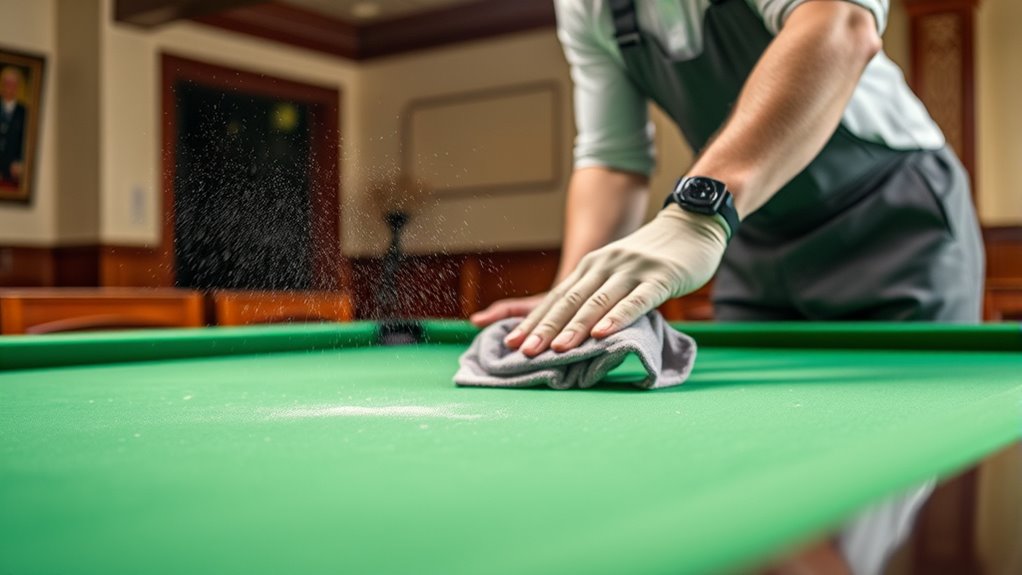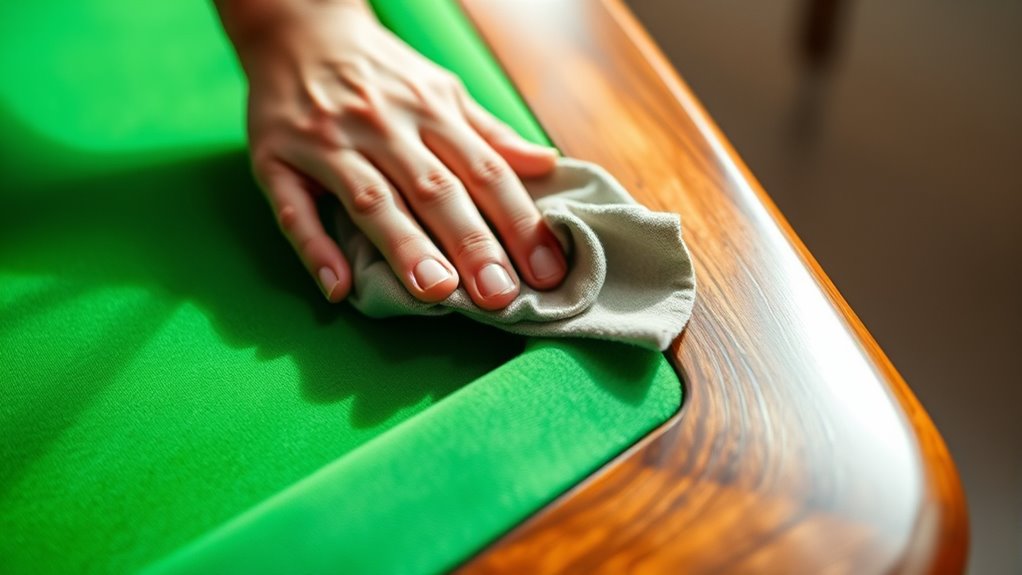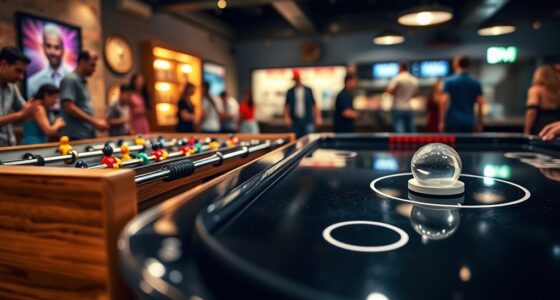To keep your pool table felt fresh, regularly brush it with a soft-bristled brush, following the nap in straight lines, and remove dust and debris. Use a fitted cover when not in use to prevent dirt and spills, and keep accessories away to avoid damage. Check the levelness of the table and tighten loose parts to maintain a smooth surface. Proper care of the wood and quick spill cleanup also help, and more tips await if you continue exploring.
Key Takeaways
- Regularly brush the felt with a soft-bristled pool table brush, following the nap, to remove dust and debris.
- Cover the table with a fitted, durable cover when not in use to protect from dust, spills, and UV damage.
- Avoid using household cleaners or steam; clean spills promptly with a dry cloth and consult professionals for stains.
- Keep food, drinks, and sharp objects away to prevent stains, punctures, and fabric damage.
- Inspect the felt periodically for wear and address issues promptly to maintain a fresh, smooth surface.

Maintaining your pool table guarantees ideal gameplay and extends its lifespan. The felt surface is the heart of your table, and proper care ensures it remains smooth, clean, and ready for action. Regular cleaning is essential. Use a soft-bristled pool table brush to remove chalk dust and debris, brushing in straight lines and following the nap to prevent damage. Cover the entire surface systematically, overlapping strokes slightly to avoid missed spots. Pay special attention to rails and where the cloth meets the cushions, as dust tends to accumulate there. If vacuuming is necessary, opt for a low-suction handheld vacuum with a soft attachment, and avoid pressing too hard—excessive force can damage the fibers. Never use harsh chemicals or soak the felt, as moisture and strong cleaners weaken the fibers and degrade the playing surface over time. Routine cleaning and care are essential but sometimes insufficient for long-term upkeep. Preventive care plays an indispensable role in maintaining your felt. Always cover the table with a fitted, durable cover when not in use to shield it from dust, spills, and UV rays that can cause fading. Before covering or cleaning, remove all balls, racks, and accessories to prevent indentations and unnecessary stress on the fabric. If you often switch between billiards and dining, consider dedicated tops to prevent sagging or tearing. Keep food, drinks, and sharp objects away from the table to avoid stains and punctures that can compromise the felt. Regularly inspect the surface for signs of wear, such as pilling, thinning, or stretching, and address these issues promptly to prevent further deterioration. Leveling your table is fundamental for consistent gameplay. Use a carpenter’s level or a specialized pool table leveler to check the slate’s level at the center and all four corners. Adjust the slate by loosening screws and inserting shims made of hardwood or composite material as needed. After adjustments, tighten the screws and recheck to ensure accuracy. An uneven slate affects gameplay and can cause long-term structural issues, especially on multi-piece tables, which may require professional assistance for precise leveling. Caring for the wood and structure involves dusting with a soft, dry microfiber cloth and avoiding water or harsh cleaners. To protect the rails, apply a thin coat of high-quality furniture wax with a lint-free cloth, then buff to a shine. Minor scratches can be buffed out with a good wood polish after testing on a hidden spot. Avoid placing heavy objects on the table, as this can warp the frame. Periodic inspections for loose joints, warping, or moisture damage help catch problems early. When spills happen, act quickly. Blot with a dry, clean cloth—never rub, as this can set stains or damage the felt. For stubborn stains, consult a professional rather than trying DIY chemical treatments. Household cleaners and steam should never be used, as they cause discoloration and fiber breakdown. Keep the table dry; moisture can swell the slate or promote mold in the felt. Regular brushing and cleaning routines, combined with attentive care, will keep your felt fresh, ensuring every game is played on a pristine surface that looks good and performs flawlessly. Additionally, understanding the cycle of wear and tear can help you better anticipate when repairs or replacements might be necessary, prolonging the life of your felt.
Frequently Asked Questions
How Often Should I Replace My Pool Table Felt?
You’re wondering how often to replace your pool table felt. If you use it daily, plan on replacing it every 1-2 years to keep your game smooth. For occasional or residential use, every 3-5 years is usually enough. Keep an eye out for signs like tears, fading, or ball issues. Regular cleaning and proper storage can extend its life, but replacement depends on usage and wear.
Can I Clean the Felt With Household Cleaning Products?
You might wonder if household cleaning products are safe for your pool table felt. It’s best to avoid harsh chemicals and strong detergents, as they can damage or leave residues. Instead, use a damp cloth with warm water or a specialized felt cleaner. Always test any product on a small, hidden area first, and gently blot stains without rubbing to protect the fibers.
What Tools Are Best for Repairing Felt Tears?
Tears in felt demand precision and care, yet the best tools for repair are surprisingly simple. You’ll need fabric glue or adhesive spray for small patches, a sharp razor blade to trim damaged areas, and matching felt patches for seamless blending. For larger tears, stitch with a strong needle and thread, then press the area with a warm iron. These tools help restore your felt’s smooth, professional look with ease.
How Does Humidity Affect My Pool Table’S Felt?
Humidity directly impacts your pool table’s felt by causing it to dampen or dry out, which slows ball roll or makes fibers brittle and prone to wear. Fluctuations loosen the felt, reducing shot accuracy. To keep it in top shape, maintain indoor humidity between 40-60%, use a hygrometer, and control moisture with humidifiers or dehumidifiers. Regular brushing and protective covers also help preserve your felt’s condition.
Is It Necessary to Hire a Professional for Felt Maintenance?
Hiring a professional isn’t always necessary, but it’s like choosing a superhero for your pool table—experts guarantee the job’s done perfectly. If your felt has wrinkles, tears, or needs leveling, a pro can save you hours of frustration and prevent costly mistakes. For simple maintenance, you might handle it yourself, but for long-term durability and a flawless finish, investing in a professional’s touch is the smartest move.
Conclusion
Keep your felt in top shape, and your game will never suffer. Regular cleaning, proper cloth tension, and prompt spills are your best allies—think of them as the guardians of your perfect shot. Remember, neglect is the silent opponent lurking in the shadows, ready to dull your play. So, treat your pool table like a loyal friend; with care and attention, it’ll reward you with countless flawless games. Are you ready to elevate your game?









